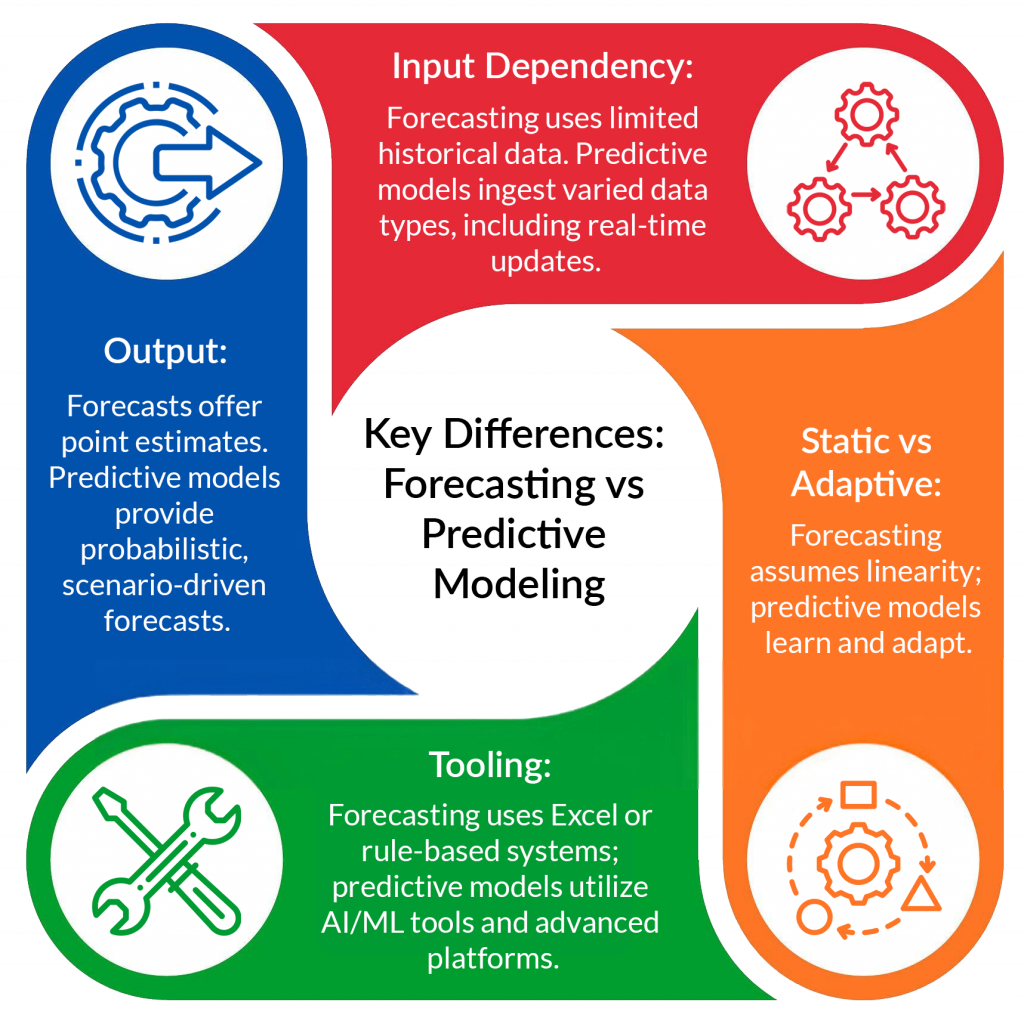In today’s volatile enterprise environment, precision planning can define success or failure.
Traditional forecasting methods that rely solely on past trends and static data no longer suffice for businesses operating in hyper-dynamic markets.
Predictive models, powered by artificial intelligence, now offer a more accurate, flexible, and actionable solution.
But what sets forecasting apart from predictive modeling, and how enterprises can effectively make the shift?
Let’s explore these differences in depth and unpack how Nsight’s AI capabilities can help you transform your planning processes into intelligent, data-driven systems.

Here’s What You Will Learn in This Blog
- Understanding Traditional Forecasting
- What Are Predictive Models?
- The Role of Data Lakehouse in Predictive Modeling
- Key Differences: Forecasting vs Predictive Modeling
- Agentic AI: Taking Prediction One Step Further
- Strategic Value of Predictive Modeling
- Forecasting Still Matters – But Predictive Models Drive the Future
- Next Steps: Funnel Deeper into Nsight’s AI Ecosystem
- Conclusion
Understanding Traditional Forecasting
Forecasting uses historical data to predict future trends.
In business, this typically includes sales, demand, supply chain, or financial projections based on time-series data.
These models rely on linear regression, moving averages, or seasonal indices to forecast future values.
However, forecasting assumes that historical patterns will repeat.
It cannot easily account for anomalies, disruptions, or multi-variable dependencies.
This rigidity poses a significant limitation in a world where customer behavior shifts rapidly, market trends fluctuate, and data sources expand exponentially.
Most enterprises still use static tools like Excel, Oracle EPM, or SAP BPC for forecasting. While sufficient for basic planning, they often lack the flexibility and speed required in modern enterprise decision-making.
To move beyond limitations, consider Nsight’s AI Starter Pack — a rapid onboarding framework for businesses beginning their AI journey.
What Are Predictive Models?
Predictive models, by contrast, are dynamic systems that analyze real-time and historical data to forecast future outcomes. They utilize machine learning algorithms like Random Forests, XGBoost, LSTM networks, and neural nets to understand relationships across multiple data types.
For example, a predictive model for demand forecasting might ingest CRM activity, weather reports, social sentiment, marketing campaign data, and historical sales to produce a more accurate forecast.
This is where the concept of Predictive Analytics plays a vital role. Instead of assuming continuity, predictive models adapt to new information, improve over time, and offer probability-based insights that drive precision.
The Role of Data Lakehouse in Predictive Modeling
To power these models, enterprises need robust data infrastructure. A Data Lakehouse integrates the flexibility of data lakes with the structure of data warehouses. It allows structured and unstructured data to coexist, enabling a 360-degree view of business operations.
Platforms like Snowflake, Delta Lake, and Google BigQuery, paired with real-time ingestion tools like Apache Kafka or Spark, create the environment predictive AI requires. Nsight helps clients design and manage these architectures, aligning them with business needs and security protocols.
If you’re considering a predictive transformation, visit Nsight’s AI Platform Services to understand how scalable infrastructures can support predictive intelligence.
Key Differences: Forecasting vs Predictive Modeling

These differences underscore why enterprises are embracing Enterprise AI to overhaul outdated planning methods. Learn how Nsight builds AI strategies That aligns with modern enterprise goals.
Agentic AI: Taking Prediction One Step Further
One of the most exciting advancements in predictive planning is Agentic AI. These are autonomous software agents capable of not just making predictions but acting on them. They simulate scenarios, select actions, and even execute them within operational systems.
For instance, in a supply chain environment, Agentic AI can predict a supplier delay, simulate alternate vendor performance, and reroute procurement strategies – all in real-time.
Nsight’s AI-Based Email Automation for Enterprise Document Management is a relevant example where predictive and Agentic AI improve efficiency, compliance, and enterprise agility.
Strategic Value of Predictive Modeling
Predictive models fuel:
- AI Implementation in marketing, HR, finance, and logistics
- Intelligent Process Automation for real-time decisions
- AI Support Systems for anomaly detection, trend analysis, and risk mitigation
- AI Model Development tailored to specific industry KPIs
It also makes your enterprise AI-ready by integrating decision systems with operational workflows. Nsight’s AI services cover end-to-end deployment, monitoring, and governance.
Forecasting Still Matters – But Predictive Models Drive the Future
Forecasting isn’t obsolete. It’s still useful for high-level trends and budget planning. But it shouldn’t be your only tool. Predictive models offer a more contextual, accurate, and responsive approach.
If forecasting provides a roadmap, predictive models deliver a GPS – real-time, adaptive, and intelligent.
Explore how Predictive AI Reshapes Enterprise Planning with real-world use cases and technical depth that reveal how top organizations are applying AI at scale.
Next Steps: Funnel Deeper into Nsight’s AI Ecosystem
If you’re ready to shift from static planning to predictive intelligence, continue your learning journey:
- Grow Your Business with AI Starter Pack
- Predictive Analytics for Business Insights
- How Predictive AI Reshapes Enterprise Planning
- AI-Based Automation in Document Management
- Explore Nsight Artificial Intelligence Services
Conclusion
Moving from forecasting to predictive modeling isn’t just about switching tools—it’s about changing how your business thinks.
Predictive AI, supported by Agentic AI and powered by solid data infrastructure, enables faster decisions, better outcomes, and a smarter enterprise.
Let your infrastructure work for you-intelligently, automatically, and in real time.
About the Author

Deepak Agarwal, a digital and AI transformation expert with over 16 years of experience, is dedicated to assisting clients from various industries in realizing their business goals through digital innovation. He has a deep understanding of the unique challenges and opportunities, and he is passionate about using cutting-edge technologies to solve real-world business problems. He has a proven track record of success in helping clients improve operations, increase efficiency, and reduce costs through emerging technologies.





